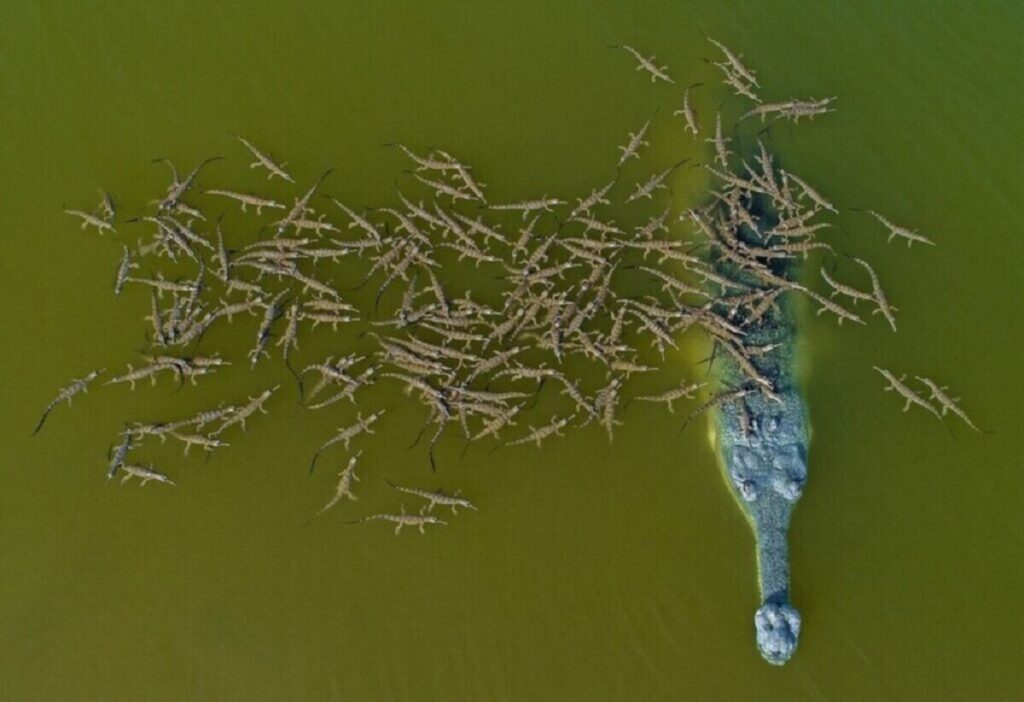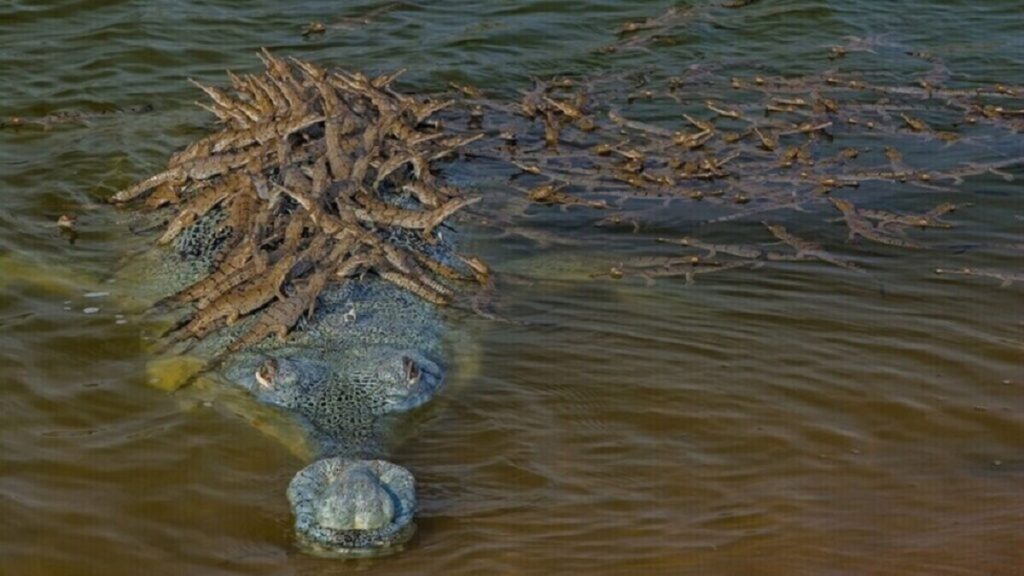In the serene waters of a wildlife sanctuary, photographer Dhritiman Mukherjee captured a moment that feels straight out of a storybook. Yet, this enchanting scene is as real as it gets—a massive crocodile gracefully swimming in a sacred river, not alone, but with a hundred baby crocodiles perched on his back. This extraordinary photograph not only highlights nature’s incredible wonders but also underscores the urgent need to protect an endangered species.
A Rare Sight in a Sacred River

The Ganges River, a sacred and vibrant ecosystem, is home to a diverse array of wildlife, including the critically endangered gharial crocodile. Mukherjee dedicated several weeks to blending into the sanctuary’s landscape, patiently waiting for the perfect moment to capture this stunning image. The result? A captivating photograph of a male gharial, likely the leader of his group, demonstrating an unusual yet effective method of childcare.
Gharials, distinct from other crocodilian species, possess long, narrow snouts and razor-sharp teeth, making the typical mouth-carrying method of transporting young impossible. Instead, these gentle giants have adapted by carrying their offspring on their backs, ensuring the young can safely navigate the river’s currents from a secure vantage point.
A Father’s Role in Gharial Society
At first glance, a male gharial ferrying around his young might seem peculiar, but it’s a crucial survival strategy. With only about 650 adult gharials remaining in the wild, the survival of each juvenile is vital. Patrick Campbell, the senior reptile curator at the Natural History Museum, explains that these impressive creatures, which can grow over four meters long and weigh up to 900 kilograms, face numerous threats due to habitat degradation and poaching.
In the Chambal River, home to the largest population of gharials, approximately 500 individuals are struggling for survival. Each successful breeding season is a beacon of hope for conservationists working tirelessly to preserve this remarkable species.
Capturing the Heart of the River

Mukherjee’s photograph does more than document a rare wildlife moment; it resonates deeply with the themes of life and familial bonds in the animal kingdom. His patience and respect for the natural world are evident in how he maintained a safe distance, using his lens to bring us closer to these majestic animals without disturbing them. This striking image has not only been shortlisted for the Wildlife Photographer of the Year but has also won a competition organized by the Natural History Museum, standing out among the top 100 entries.
As someone who has spent years crafting stories online, the narrative behind this image strikes a personal chord. It serves as a poignant reminder of the delicate balance of nature and the incredible ways animals adapt to their environments. Here in Austin, where community and conservation efforts are highly valued, stories like these inspire us to appreciate and protect the natural world around us.
Mukherjee’s photo is a testament to nature’s resilience and the enduring spirit of fatherhood in the wild. It invites us to pause and marvel at the complexities of life that often go unnoticed. In our fast-paced lives, it’s these moments of natural peace and remarkable survival that truly captivate and inspire us.
Final Thoughts
The discovery of a male gharial with a hundred baby crocodiles on his back highlights the extraordinary adaptability of wildlife and the critical importance of conservation efforts. Mukherjee’s photograph not only captures a breathtaking moment but also serves as a powerful symbol of hope for the survival of an endangered species.
As we celebrate this remarkable image, let it remind us of our responsibility to protect and preserve the natural habitats that support such incredible life forms. By supporting wildlife conservation initiatives and spreading awareness, we can ensure that future generations continue to witness and cherish the beauty and resilience of animals like the gharial.






